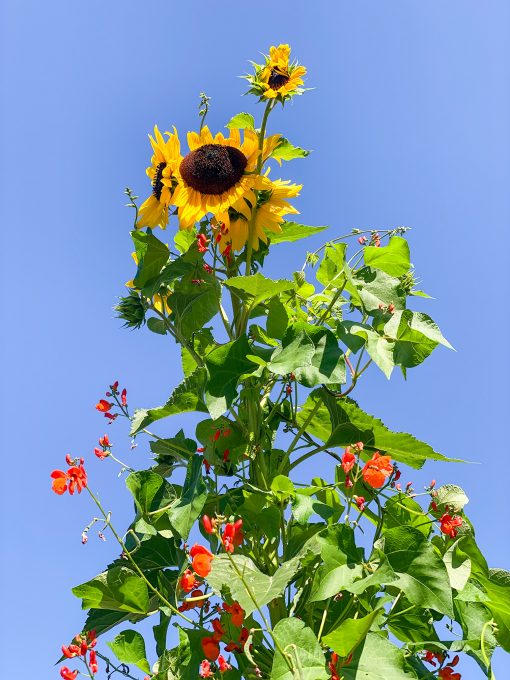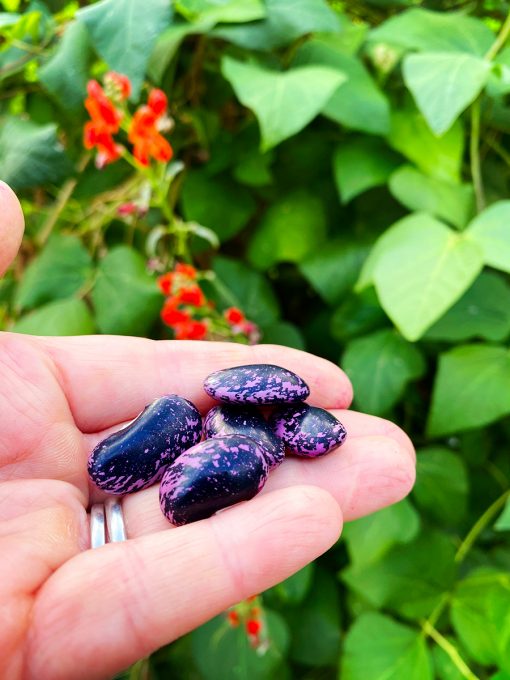make time for scarlet runner beans
more than a pretty face
First published in the November 2024 edition of Grapevine, the newsletter for Yamhill County Master Gardeners.
Brown seed pods hang heavy among green leaves and still-immature beans in the garden. My scarlet runner bean vines ignore that their sunflower companions are now asleep. They seem oblivious that the pollinators have moved on. It’s nearly November. Only the birds looking for seed visit the garden in the finite days before frost.
Scarlet runner beans keep their own time. They continue to wind clockwise around the trellis. The plants are both early-to-rise and last-to-bed in the garden every year.
There will always be a place in my garden and my heart for scarlet runner beans. Phaseolus coccineus are a terrific trifecta of benefits. They are vibrant and vivacious vines. The flowers make a stunning addition to any space. But they are more than just a pretty face. The heirloom legumes also provide good health to both plants and humans.
With traffic-stopping red flowers, pollinators can’t help but visit a plot with scarlet runner beans. The flowers that open at sunrise and fade at sunset welcome Anna’s hummingbirds en masse. The feathered pollinators zip and zoom with a quick rest on the trellis supports. They create a celebratory and chaotic display.
The busy bees and butterflies also get in line for the sweet nectar. The crimson color mixes well with golden branching sunflowers, orange nasturtiums, and deep purple eggplants.
Proving their power beyond aesthetics, the scarlet legumes have nitrogen fixing roots. These are a big help in preparing a raised bed properly for next season’s hungriest plants.
Scarlet runner beans average 125 pounds of nitrogen per acre. That’s a good match for what tomatoes, onions, and cabbage require per season.
Scarlet runner beans can also perennialize in the right conditions. They have deep taproots that can mobilize minerals from the sub-soil back to the surface.
This gardener has always pulled up the runner beans as an annual. But not this year. I will be testing this “perennial” idea.
According to the University of Wisconsin-Madison, “P. vulgaris in mild climates (zones 7 – 11) is a short-lived perennial vine, forming tuberous roots from which new shoots sprout annually in areas with frost where it is not evergreen.”
Scarlet runner beans are often grown for their looks, but they are deliciously edible in almost all phases. Eat the flowers! They taste like sweet beans. Snack on the fresh baby bean pods all summer. BUT do not eat the mid-season fibrous and toxic green pods. Instead, leave the pods to grow and dry in place.
With patience, the gardener will reap the rewards of the astonishingly pretty marbled black and purple red dry beans. Store the fully-dried beans in glass jars for a nourishing boost of protein all winter. And of course, save a handful of the dried beans for planting the next spring.
The instant pot has given heirloom beans a big boost in popularity. It is hard to argue with the new ease and efficiency of preparing dried legumes. When it comes to soaking and cooking, the scarlet runners are treated the same as a kidney bean. Scarlets will stay whole but become creamy inside. They are the perfect bean for cooling and packing in freezer containers to later add to stir-fries, salads, and soups.
Growing Scarlet Runner Beans
Scarlet runner vines grow fast and furious. They easily reach 10-15 feet tall/long. I have tried many a support for the vines. A sturdy metal trellis is ideal. My homemade bamboo teepee “almost” made it before twisting and tumbling under the weight. It was comedy to see my twine reinforcements like clotheslines attached to the fence posts.
The “Three Sisters” approach from Indigenous American agriculture approach requires more than the typical one bean to one stalk of corn. Scarlets demand more like one bean to ten stalks whether it be corn – or my personal favorite – sunflowers.
Young runner bean plants need protection from rabbits and slugs. They should not be fertilized heavily – if at all — as this will promote lush foliage instead of flowers and beans. The legumes need full sun and can be sown two inches deep and four inches apart before the soil has warmed completely. But not so early that you frost young leaves.
To save seed for planting is the same for culinary uses. Allow pods to remain on the vines as long as possible, preferably until they are completely dry and the seeds rattle inside. If frost threatens, pick the mature pods and bring them indoors to complete drying.
An Oregon History Lesson
Native to the Americas, beans were one of the great gifts to the Old World from the New World where they had been cultivated for 10,000 years. But beans weren’t grown in the Pacific Northwest until the Hudson’s Bay Company established Fort Vancouver in the 1820s. Beans had an advantage over salt pork and biscuits on 19th-century sailing vessels. Leftover legumes could be planted.
Settlers on the Oregon Trail turned beans into a pioneer staple. The iconic Dutch oven that jangled in every wagon carried dry beans. As it was time-consuming – no instant pots made that journey – the camp cooks often simmered big batches into a hummus-like mush to spread on bread.
Many heirloom bean varieties have been quietly growing in Oregon for more than a century. Beans once trucked in from California grow better here. While dry heirloom beans might never be the most productive plant in a field, their beauty and impeccable flavor make it feel like a farmer’s duty to host and preserve a small piece of history.
Have these timeless beauties wound their way into your heart? I wonder how many home gardeners have embraced what OPB calls “Oregon’s legume legacy.”
For myself the inner debate has begun on which heirloom legume will accompany the scarlet runner beans next spring. I am mindful though that runner beans readily cross-pollinate. They must be isolated in order to have seed from heirloom varieties come true.
Still I dream of adding maybe Marcella (named for legendary Italian cookbook author Marcella Hazan). Or perhaps the Whipple, a creamy borlotti with burgundy-red skin and light pink speckles. The Whipple’s are rumored to either have arrived with the pioneers or with a family who relocated to Oregon after working with Dr. Martin Luther King Jr.
But I find little about the Marzan and Whipple flowers. Are they as beautiful? As tasty? It may not be worth the risk for this anthophile to stray when the scarlet runner bean truly is the total package.
If you liked this article, please consider subscribing. You’ll get an email when I publish sometime new!




I’ll be trying these next year in a new location with sunflowers. I had great luck with sunflowers last year, moved them to a new location this year and failed. Oh well. Are you all certified and ready to graduate?
I love that we just roll with the punches with our gardens! I’m thrilled to be a certified Master Gardener. It’s been such a great year with you all.